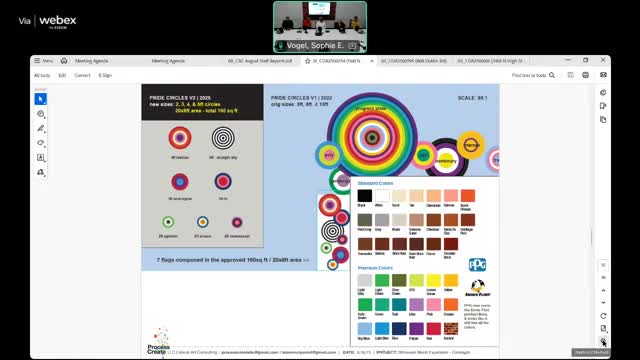Columbus City Council selects artist Andy Clarkson for pump station project
August 20, 2025 | Columbus City Council, Columbus, Franklin County, Ohio
This article was created by AI summarizing key points discussed. AI makes mistakes, so for full details and context, please refer to the video of the full meeting. Please report any errors so we can fix them. Report an error »

The Columbus Art Commission held a special meeting on August 20, 2025, where key discussions centered around innovative public art projects aimed at enhancing community engagement and education. One of the standout topics was the use of thermal plastics in street art, a collaboration between local artists and the City’s Department of Public Service. This initiative not only aims to beautify the streetscape but also addresses safety concerns regarding slip factors on surfaces where art is displayed.
James Young, Deputy Director of the Department of Public Service, played a pivotal role in connecting artists with local manufacturers of thermoplastic materials. This collaboration has sparked creative conversations about reimagining how these materials can be used in public art, making the process both educational and visually appealing for residents.
Commission members expressed enthusiasm for the project, highlighting the importance of accessibility to information about the art. Suggestions were made to incorporate QR codes that would allow passersby to learn more about the identities represented in the artwork. This feedback underscores a community desire for deeper engagement with public art, transforming it from mere decoration into a source of education and cultural representation.
In addition to the thermal plastics project, the meeting also addressed a new initiative involving a pump station art project. This project aims to educate the community about water utility services while beautifying a significant infrastructure site. The commission reported a strong response to their call for artists, with over 70 applicants. Ultimately, artist Andy Clarkson was selected to create a piece that reflects the local ecosystem and the utility's role in the community.
The discussions at this meeting reflect a broader commitment by the Columbus Art Commission to foster community involvement in public art and to ensure that these projects resonate with the diverse identities of the city’s residents. As these initiatives move forward, they promise to enhance not only the aesthetic appeal of public spaces but also the educational value of art in the community.
James Young, Deputy Director of the Department of Public Service, played a pivotal role in connecting artists with local manufacturers of thermoplastic materials. This collaboration has sparked creative conversations about reimagining how these materials can be used in public art, making the process both educational and visually appealing for residents.
Commission members expressed enthusiasm for the project, highlighting the importance of accessibility to information about the art. Suggestions were made to incorporate QR codes that would allow passersby to learn more about the identities represented in the artwork. This feedback underscores a community desire for deeper engagement with public art, transforming it from mere decoration into a source of education and cultural representation.
In addition to the thermal plastics project, the meeting also addressed a new initiative involving a pump station art project. This project aims to educate the community about water utility services while beautifying a significant infrastructure site. The commission reported a strong response to their call for artists, with over 70 applicants. Ultimately, artist Andy Clarkson was selected to create a piece that reflects the local ecosystem and the utility's role in the community.
The discussions at this meeting reflect a broader commitment by the Columbus Art Commission to foster community involvement in public art and to ensure that these projects resonate with the diverse identities of the city’s residents. As these initiatives move forward, they promise to enhance not only the aesthetic appeal of public spaces but also the educational value of art in the community.
View full meeting
This article is based on a recent meeting—watch the full video and explore the complete transcript for deeper insights into the discussion.
View full meeting
